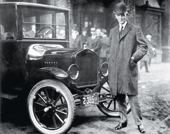Why Innovations Are Arguments
Too many executives confuse what an innovation is with what an innovation would do for them if they had one. The solution? Think of innovation as an if-then argument.
Topics

Henry Ford’s argument for the Model T can be expressed
as an if-then statement.
Image courtesy of Ford Motor Company.
Attend almost any conference on innovation, and one will hear someone in the audience ask, “Yes, but how are you defining ‘innovation’?” Why is there no clear, shared meaning of “innovation”? I believe it is because most executives confuse what an innovation actually is with what an innovation would do for them if they had one. For example, most companies think of an “innovation” as something that wins a sale with a better solution, increases revenue or takes market share from a competitor. But those aren’t definitions of innovation. They’re outcomes executives would like to get from innovation.
The problem is a serious one, not the least because companies send engineers, “technology entrepreneurs” and “technology scouts” in search of innovations when a shared understanding of what they are looking for may not exist across the organization’s people and functions or between “scouts” and managers. More significantly, to “innovate” means to “regenerate” — and most companies decline or fail because they fail to regenerate.
I propose that all true innovations are arguments. By this I mean that all innovations are composed of three elements: a proposition and a conclusion linked by an inference. I further propose that this is not merely a convenient or workable definition that covers most instances of innovation. Far from it: Stating that innovations are arguments is not just stating a definition — it is an identity, an equality. Innovation = Argument.
Let me explain. When the late Steven Jobs went to Xerox’s Palo Alto Research Center in December 1979 to kick around the lab to see what was up, he made an argument — an innovation. He stumbled on a proposition — the graphical user interface — and inferred that this interface would be the way that everyone would experience computing. Jobs later told Rolling Stone, “Within 10 minutes, it was obvious that every computer would work this way someday. You knew it with every bone in your body.” Steve Jobs was an innovator because he could make inferences between technology propositions and conclusions about human experience.
Arguments can always be expressed as if-then statements: If we agree to a proposition being true, sound or valid, then we can infer a conclusion.

Comments (4)
dan
lalatendurath
anumakonda.jagadeesh
globalroundhouse